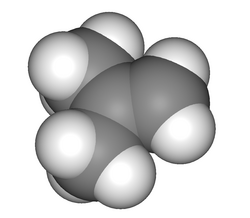2-Methylpropene
| 2-Methylpropene | |
|---|---|

| |
| IUPAC name | 2-Methylpropene |
| Other names | Isobutene gamma-Butylene 2-Methylpropylene |
| Identifiers | |
| InChI | InChI=1/C4H8/c1-4(2)3/h1H2,2-3H3 |
| CAS number | [] |
| EC number | |
| UN number | 1055 In Liquefied petroleum gas: 1075 |
| RTECS | UD0890000 |
| ChemSpider | |
| PubChem | |
| SMILES | |
| Properties[1] | |
| Molecular formula | C4H8 |
| Molar mass | 56.11 g mol−1 |
| Appearance | Colorless gas |
| Density | 0.5879 g/cm3, liquid |
| Melting point |
−140.3 ºC |
| Boiling point |
-6.9 °C, 266 K, 20 °F |
| Solubility in water | Insoluble |
| Hazards[2] | |
| EU index number | 601-012-00-4 |
| GHS pictograms |  
|
| GHS signal word | DANGER |
| GHS hazard statements | H220 |
| GHS precautionary statements | P210, P377, P381, P403 |
| NFPA 704 | |
| Flash point | flammable gas |
| Autoignition temp. | 465 °C (869 ºF) |
| Explosive limits | 1.8–9.6% |
| Related compounds | |
| Other butenes | 1-Butene cis-2-Butene trans-2-Butene |
| Other compounds | Isobutane |
| Except where noted otherwise, data are given for materials in their standard state (at 25 °C, 100 kPa) | |
Isobutylene (or 2-methylpropene) is a hydrocarbon of significant industrial importance. It is a four-carbon branched alkene (olefin), one of the four isomers of butylene. At standard temperature and pressure it is a colorless flammable gas.
Uses
Isobutylene is used as an intermediate in the production of a variety of products. It is reacted with methanol and ethanol in the manufacture of the gasoline oxygenates methyl tert-butyl ether (MTBE) and ethyl tert-butyl ether (ETBE), respectively. Alkylation with butane produces isooctane, another fuel additive. Isobutylene is also used in the production of methacrolein. Polymerization of isobutylene produces butyl rubber (polyisobutylene). Antioxidants such as butylated hydroxytoluene (BHT) and butylated hydroxyanisole (BHA) are produced by Friedel-Crafts alkylation of phenols using isobutylene.
Manufacture
Isobutylene can be isolated from refinery streams by reaction with sulfuric acid, but the most common industrial method for its production is by catalytic dehydrogenation of isobutane.[3] In the 1990s, the production of isobutylene increased dramatically as the demand for oxygenates such as MTBE grew. Key manufacturers of this product are Texas Petrochemicals and Lyondell in North America.
Safety
Isobutylene is a highly flammable gas and presents an explosion danger. Usually stored as a compressed gas, if released it may produce an oxygen-deficient atmosphere that presents an asphyxiation hazard.[2]
See also
References
- ↑ The Merck Index: An Encyclopedia of Chemicals, Drugs, and Biologicals, 11th ed.; Merck, 1989. ISBN 091191028X, 5024.
- ↑ 2.0 2.1 Isobutene; International Chemical Safety Card 1027; International Labour Organization: Geneva, April 2000, <http://www.inchem.org/documents/icsc/icsc/eics1027.htm>
- ↑ Olah, George A.; Molnár, Árpád Hydrocarbon Chemistry; Wiley-Interscience. ISBN 978-0471417828.
External links
- International Chemical Safety Card 1027
- SIDS Initial Assessment Report for Isobutylene from the Organisation for Economic Co-operation and Development (OECD)
| Error creating thumbnail: Unable to save thumbnail to destination | |
This page was originally imported from Wikipedia, specifically this version of the article "Isobutylene". Please see the history page on Wikipedia for the original authors. This WikiChem article may have been modified since it was imported. It is licensed under the Creative Commons Attribution–Share Alike 3.0 Unported license. |


